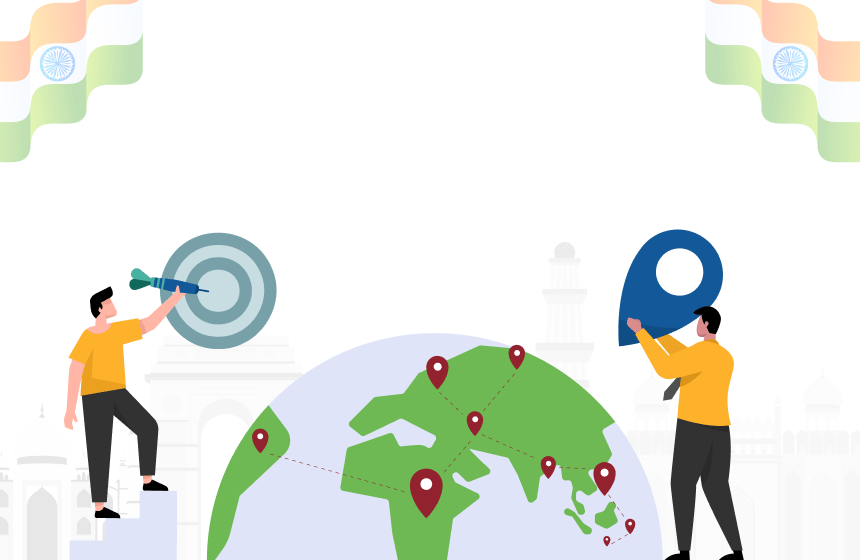India is an emerging economy with a huge consumer market that makes it an alluring region for global brands and investors. It is the 5th largest economy by GDP, and 2023 has been a great year for the Indian economy, as they’ve scaled 8.7% YoY, which is its highest climb in the last decade. Moreover, the country has also very well navigated global inflation compared to many other countries worldwide.
It can be a dream for any company to scale in the Indian market and capture its maximum market share. However, where there are opportunities, challenges are also there. India is a saturated market, and stepping into the region is not as easy as it may seem. When we analyzed the success stories of major brands in the Indian market, the key factor that contributes to their success is localization. Undoubtedly, localization is the way to go for brands that want to thrive in the culture-rich and linguistically diversified market of India.
Let’s have a closer look at the opportunities, and challenges of entering India and the best localization practices that brands can adopt to make their globalization journeys smoother.
Table of Content
- Why is India a Lucrative Market for global businesses?
- Emerging economy
- Access to a massive customer base
- Digital competitiveness
- Business policies & government initiatives
- Low operational cost
- Key Challenges You May Face Indian Market
- Complex language structure and diversity
- Myriad of Cultures Colliding With Each Other
- Limited availability of Indian language experts
- Balancing standardization and Localization
- Best Localization Practices to Win the Indian Market
- Conducting extensive market research
- Adapting your brand to the audience’s language and cultural norms
- Employing expert language translators
- Adapting Visual elements and formatting
- Tailoring marketing strategies to suit local preferences
- Localization Examples of Famous Brands in India
- McDonald’s
- Amazon India
- Coca-Cola
- Puma
- Cadbury
Why Is India a Lucrative Market for Global Businesses?
1. Emerging Economy
It won’t be any hard for international businesses to sustain their growth in the Indian market because of their stable economy. The rise of government investments, structural reforms, and democratic values have enabled India to maintain robust economic stability. It is a developing economy with a lot of room for innovation and investments. For any company, it is a good decision to invest in India at this time and make the most of the market share.
2. Access to a Massive Customer Base
India has a huge population of 1.4 billion people, so if you want to target India, you will automatically have access to a huge market. The good thing about their population is that it’s mostly young people with working capacity who act as a magnet for foreign companies and investors. Because of the high consumer base of the country, it is the world’s largest market for manufactured products and services.
3. Digital Competitiveness
The West mostly has the notion of India as a poor, illiterate, and regressive country, but it is just a fictional Western view of the region. Indians are tech-savvy, and this country has a huge potential for tech companies to grow. So, technology companies from industries like IT, telecommunication, healthcare, engineering, and textile can make good revenues in the Indian market.
4. Business Policies & Government Initiatives
The latest business reforms in India made it much easier and more convenient for foreign brands to set up their operations in this region. The law related to Goods and Services Tax, Land Acquisition Bill, and Direct Taxes Code Bill has a huge impact on the transfer of products around the country. It makes the environment quite suitable for foreigners to establish their businesses here. Moreover, the Indian government keeps launching new schemes and policies to make their country compatible with foreign investments. The foreign direct investment policy of the government made it much easier for investors to get away with the process of investment, and they didn’t have to get any prior approval from the government.
5. Low Operational Cost
If a foreign company wants to establish its operations in the Indian market, it can significantly reduce its expenses by physically setting up its business in the region. It saves the cost of supplying the manufactured goods from other countries, and they manufacture the goods in Indian markets instead. Moreover, the labor in India also costs way less than in most Western countries, which is also a plus point to expanding business operations cost-effectively.
Challenges You May Face in the Indian Market
1. Complex Language Structure and Diversity
India is a diverse country when it comes to the local culture, regional languages, and religions of people. Although Hindi is known to be the official language of Indians, there are around 22 official languages in total. The small-town people in India are more fluent in their local languages. Brands may have a hard time getting along with people speaking different languages. If you are only targeting people from Urban India, Hindi translation alone might work for you; however, when it comes to reaching out to the masses you may need to consider other regional languages as well.
2. Myriad of Cultures Colliding With Each Other
Cultural diversity is also another huge challenge when it comes to the target Indian market. There is not just one culture that you can pick to create your brand persona. In India, people from different religions live together, so the brand must show respect to all regions. Sometimes it makes it hard for food companies to create menus that go well with everyone’s dietary preferences. Finding the right way to communicate with your audiences is difficult, and there are always chances of miscommunication because of cultural complexities.
3. Limited Availability of Indian Language Experts
Indian languages are not spoken worldwide, except by Indians. Brands can have a hard time finding professional linguists for Indian languages. You might find people online providing average translation services, but not good enough to give your brand a breakthrough in the Indian market. So, brands have to rely on very few translators who are experts in their target domain, understand their brand needs, and provide quality translations.
4. Balancing Standardization and Localization
Global brands are mostly stuck with whether they should go for brand standardization or localization. Well, it mostly depends on how big or small you are. If you are not already a big company, you better focus on the brand’s professional localization management. It can cause financial issues for small businesses because localizing for a market like India may require a fortune. However, it also depends on the regions you are targeting and how many people you want to reach out to.
Best Localization Practices to Win the Indian Market
1. Conducting Extensive Market Research
Knowing your target market and understanding your customer’s demands is the first thing you need to figure out before entering the Indian market. You should do detailed research specific to your brand and target audience. For market research, you can design surveys by creating open-ended questionnaires, you can also conduct interviews with potential customers. It also will help you get into the minds of your customers and adapt your products, services, and marketing efforts accordingly.
2. Adapting Your Brand to the Audience’s Language and Cultural Norms
If you get the language and culture thing right, you can create a really profitable brand that perfectly resonates with local audiences. India has an English-speaking audience though, but still, try to be as local as possible in your approach to better connect with your target customers. Translate your brand’s content into regional languages ideally, or at least in the Hindi language. Moreover, making the translations culturally appropriate is also important to develop trust in locales.
3. Employing Expert Language Translators
Hiring the right resources for your translation project management is significant to communicate your brand message effectively to Indian audiences. You can either hire in-house translators or work with remote resources directly from India. Moreover, translators should have good experience working in your business domain. You can also partner with a reliable Indian language service provider that would have experienced professionals to fulfill your translation needs.
4. Adapting Visual Elements and Formatting
You need to go deeper with your localization and adapt your visual user-facing elements, such as images, videos, and animations to local preferences. It will make your product or services reflect the local culture and customs of the target audiences. Moreover, make sure the formatting of date, time, and currencies is also adapted to what is more familiar to locales. It will help you significantly enhance the user experience with your brand in foreign markets.
5. Tailoring Marketing Strategies to Suit Local Preferences
For each market, you must modify your marketing strategies based on your target customer’s interests and cultures. Localizing your marketing strategies will allow you to maximize your marketing results and make the most of your localization efforts in the Indian market. To tailor your marketing strategy to your overseas customers’ needs, you must have a comprehensive understanding of their cultures and values. If you are not already familiar with the target culture, you can also get assistance from a professional culture consultant.
Localization Examples of Famous Brands in India
1. McDonald’s
It is a leading fast-food company that has managed to successfully run its operations around the globe with its smart localization strategies. When you look at their Indian menu, they have perfectly tailored their food items to local tastes and preferences. You will find more vegetarian options on McDonald’s India menu because the majority of the population is vegetarian. McAloo Tikki Budget, made with a mashed potato patty, is a famous non-veg burger in India. Moreover, they also offer the McSpicy Paneer burger and McVeggie made with special Indian species.
McDonald’s has approached localization really well in the Indian market which allows them to cater to the demands of such a large population.
2. Amazon India
Amazon is the biggest retailing company globally that has made special customization to its platform to meet the unique needs of the Indian population. On Amazon India, you can find products from local vendors as well as international brands. Considering local preferences, Amazon offers familiar payment methods and cash on delivery. Moreover, they also localize their marketing campaigns to resonate with locales. For instance, they have run a successful “Apni Dukaan” campaign in India, which is the translation of “Your Shop”. The company kept personalizing its marketing strategies and created a local brand persona.
3. Coca-Cola
Coca-Cola has been operating in the Indian market for more than 60 years now, and it is indeed one of the most lucrative markets for this leading beverage company. The company has run many successful localized marketing campaigns over the years to appeal to a maximum number of people. They also keep personalizing their product and introducing new flavors, such as Thums Up (carbonated drink), and Maza (mango flavored juice) are two famous Coca-Cola beverages in India. Similarly, Coca-Cola keeps launching different campaigns in festival seasons. The “Share a Coke” campaign was very successful when the company printed common Indian first names on their bottles giving their product a personalized feel.
4. Puma
It is a famous German sportswear brand that has localized its marketing campaigns to capture the attention of Indian customers. India has a great passion for cricket, and Puma knows how to capitalize on cricket-inspired sportswear products. They have partnered with the Indian Premier League (IPL) cricket tournament and designed special clothing and accessories to appeal to cricket fans around the country. The company has also hired famous Indian celebrities as its brand ambassadors and keeps launching other limited-edition products for the cricket season.
5. Cadbury
It is a well-known chocolate brand that has a huge market in India, and it knows how to design its marketing around love, family, and happiness. Cadbury has introduced many chocolate flavors, especially for Indian customers. Cadbury Dairy Milk Silk, Kesar, and Paan chocolate are quite famous among Indian customers. Similarly, Cadbury keeps launching its “celebration” range for festival seasons.
Final Thoughts!
India is an attractive market for investments with a huge consumer market; however, it is not perhaps the easiest market to step into. Huge cultural and linguistic diversification makes India a hard nut to crack. Yet, international brands have a huge potential to grow in India if they know how to approach their localization and marketing strategies right. If you want to hit the Indian market, you must carefully identify the market opportunities, and have a robust strategic plan in place to combat the challenges with localization best practices.
Make sure you have the right localization resources, tools, and team to help you smoothly navigate your way through the Indian market.



